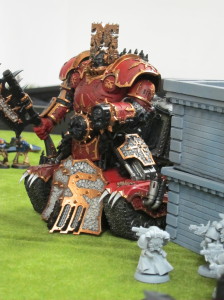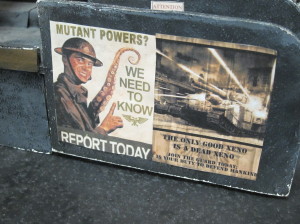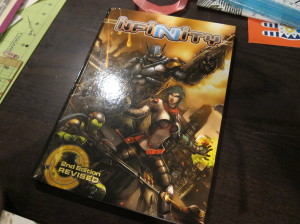Yesterday was Redcap’s January tournament. As usual it was 1850 points, everything allowed—all supplements and Forgeworld units permitted for standard 40k, which is basically everything at this point. This was the first tournament in our group since Escalation and Stronghold Assault came out, and the subsequent arrival of superheavies. Turnout was low due to a snow storm, but a Shadowsword, Lord of Skulls, and Barbed Hierodule all made an appearance, plus my little Imperial Bunker.
On the one hand, as usual it was a really fun day. Redcap’s executed the tournament well as always, and it is a great group of people. I had three good games, it was fun hanging out, and I was glad I did not let the snow turn me away. On the other hand, it was also such an unenjoyable event and highlighted so many issues that overnight I have little interest in competitive 40k. Keep in mind, that’s after picking up two crushing victories and a majority of the bonus points to take second place, without myself taking a superheavy. Other than a basic bunker (AV14 + 1 Void Shield + 1 Quadgun), I brought my usual vanilla Marines (play as Salamanders) and still did pretty well, so the concerns below aren’t straight sour grapes. I’m sure some of these will be addressed as people work out effective counter tactics and units, FAQs come out, and everyone becomes more familiar with the relevant rules. Many of them though represent fundamental issues in current 40k that are unlikely to be addressed at all, let alone GW’s historical poor performance resolving even minor rules questions and imbalances.
These concerns, explained in detail below, basically fall into three areas:
- Cost and accessibility;
- Imbalance and crippled strategy;
- Ambiguity and rules problems.
Note that two of those have nothing directly to do with most players’ primary concern of overpowered units.
Cost and Accessibility
This hobby is not a cheap one, but I don’t agree with the common sentiment that GW’s models are absurdly costly across the board. The core units are actually favorably comparable to other systems (especially given the quality and poseability), and the mid-range stuff not unreasonable. More esoteric units though are questionable, and most of the books definitely well overpriced. Unfortunately, the new power balance is gravitating heavily toward those units and ever more numerous books.
I don’t think an average player could show up to a tournament now—even just lightly sprinkled with the crazier stuff as Redcap’s tournaments tend to be—without those models and supporting books and still place about average. The expansions, dataslates, etc., are making it increasingly about who’s willing and able to put out cash for better units. That’s unappealing to everyone, and raises even higher the already substantial barriers to bringing in new players. It’s not a huge community to begin with, it won’t survive long at all turning off old players and discouraging new ones.
Beyond the costs, even if you’re willing and able to put out the money, access is problematic. I would love to buy more Forge World stuff, mostly just basic infantry for more modeling options, but it’s a large hassle, expensive, and absurdly slow for this day and age. Previously that was unfortunate for the hobby aspect but had no impact on competitive gaming. Now though, if you need that stuff to be competitive, that puts a big damper on things. Notably, that doesn’t just mean models, to really be competitive most people also need a pretty broad swath of books beyond their own forces.
Superheavy Imbalance
I do think some of the new elements are not just a bit imbalanced, many of them don’t even make sense or aren’t meant to be comparable within the same game—standard 40k vs Apocalypse. Keep in mind, at Redcap’s we haven’t seen all of the different supers yet: Nobody brought a Titan, superheavy flyer, or flying gargantuan creature yesterday. I tend to agree that they’re pricey (in points as well as dollars) but extremely survivable and efficient, more so than a Baneblade chassis and the other “small” vehicles and creatures. I have to believe that anybody who’s played Apocalypse will tell you that these items just don’t scale in the same way as the previous “regular” units. They’re costly, but not nearly commensurate to their stats and abilities.
Even just the Baneblades highlight that point. They’re the canonical “baby superheavy” and yet they’re beasts in the regular game. For about 500 points they’re literally as many hull points and nearly as well armored as 750 points of Landraiders, and only the very talented or very foolish would consider three Landraiders not a challenge to take down. On top of the hull points and a number of smaller benefits (better tank shocks, etc.), superheavies get more and much stronger weapons, each weapon can shoot a different target, and the model completely ignores almost everything on the vehicle damage table. Those are huge buffs compared to a standard vehicle, being able to split fire and not being able to be stunned, immobilized, or take weapon destroyed results, and you’re not really paying points for them. For 2/3 the cost of the previous baseline “ultra heavy” block you’re getting a substantially better unit. Worse, a number of the other supers, even just in the Escalation book, are more survivable and just as killy. I could see my army as-is possibly taking down a Baneblade. I can’t see it doing hardly anything to a Lord of Skulls (frequently has a 3+ invulnerable, regenerates hull points, fights back in assault, and so on).
Without your own super—or a D-weapon equipped major fortification—by and large it’s going to be extremely difficult to take down a super, and it won’t be impaired in any way even as you chip away at it. You may get some victory points (for every 3 hull points taken), but you’re at a huge disadvantage in kill points missions and the others like Emperor’s Will or The Relic with a low number of objectives. I was going to say they’re only compensated for by missions with a whole bunch of objectives, thus penalizing supers for absorbing points not spent on troops units to score, but Imperial Guard also counter that easily.
D Is For Dumb
Meanwhile, as it’s rolling around unstoppably, a superheavy is smashing and destroying at will, particularly if it has a D-weapon. By ignoring all saves and cover, D weapons make almost everything else in the standard game almost pointless. They generally have absurd range as well so you can’t even run away from them. Without benefit from armor, improved cover, maneuverability, or other defenses, you may as well not bother. The old adage about Apocalypse now applies to 40k: It’s a game of setting up and then packing away models. A vast swath of the strategy and play in 40k is eliminated as you should never take anything but the cheapest possible troops to hold objectives. They’re all equally killable now so you should pack in as many bodies as you can and spend the rest of the points on your own D-weapons, because that’s basically all that matters.
That’s a huge problem because it reduces the strategic depth of the game, making much more like its old days of two static gunlines shooting at each other in point & click fashion. It also really hurts different play styles and even entire factions, putting even more focus on long range shooting and minimizing maneuverability and assault. Even just by sheer model count, managing a whole army of units and enacting a lot of synergistic abilities through coordinated moves is a skill that’s not nearly as critical if one mega unit occupies a huge fraction of your points. Though never a huge fan of piling on models for games at stupidly high point values, I’m also not interested in driving around a couple large models.
Unfortified Positions
I think in GW’s view fortifications are supposed to balance all that out. We’ll set aside for now the point earlier about that still requiring more books and largely more expensive models. We’ll even set aside the fact that this only helps armies that can sit back and shoot with high strength from a distance and out of sight. Even ignoring those two considerable points, fortifications just don’t balance against D-weapons. The rules actually don’t even make any sense if you assume that was the intent.
As written, the void shields and buildings are completely out of whack. On the one hand, they make your units essentially invulnerable to standard units. Guys inside can’t be assaulted or shot, you often may not be able to reach the battlements even theoretically to assault there, and the shields and bunker walls defeat most standard units’ attacks. On the other hand though, they’re completely useless against D weapons and even high strength blasts: Against the former they’re all but automatically destroyed, and against the latter stand a high probability of collapsing. Worse, they’re actually death traps. Say you’ve got a pretty standard configuration: An occupied bunker with a unit of 5 on the battlements, all under 2 void shields. That gets hit by a D blast. The guys on the battlements generate 5 hits which take down the 2 shields automatically and also kill 3 guys on anything but a 1. The bunker also takes a hit since it’s under the blast as well, and explodes on anything but a 1. Note: Doesn’t take damage; explodes. As an effect of that, the guys on the battlements take another D6 S6 hits and the guys inside take 4D6 S6 hits before they both run away and then presumably get stomped on. Some bunker.
The only reasonable way to use the bunker then is to not put any guys on top, such that the shields absorb the single hit on the bunker. Somehow that doesn’t seem to be the vision GW actually has for fortifications, with guys all over the battlements in every picture. Alternatively you could apply a super technical distinction that the battlement is, per the text, the top level of a ruin, a different level from the building, and therefore a blast or template can’t generate hits on both the unit on the battlements and the building itself. That’s super non-intuitive though, I actually haven’t seen anyone else argue that, and basically irrelevant. Either way, the shields are fairly easy to be crushed and your building exploded if there’s a superheavy around.
Unbelievably, a bunker—starting from 50 points and presumably designed in game terms to protect your dudes against crazy firepower—is actually worse as a defense from D-weapons than a 35 point Rhino. They both get blown up pretty much automatically, but the latter only causes a S4 hit on each guy inside, while the former does 4D6 S6 hits. Extending that comparison, in an often overlooked rule, you can’t put objectives in or on buildings and fortifications. You also can’t be embarked inside to score, just like a vehicle. So just like a transport, your dudes need to flee their amazing fortress and run out into the open on Turn 5 to sit there getting hammered by D-weapons before they can claim the objective.
Fog of War
Unbelievably, it gets even worse for fortifications and the people who have to play against them. The rules are fairly incomplete, and often make little intuitive sense. Stronghold Assault actually did go a long way to cleaning up the building rules, making them much more clear and streamlined from those in the 6th edition core rulebook. But even those have numerous problems and ambiguities. Just a sampling:
- It’s actually not at all clear that the above discussion is how void shields are supposed to work, though that’s definitely how they’re written. In terms of balancing out D-weapons, it would make much more sense if each shield blocked a shooting attack, rather than a hit, and is clearly how many people are reading it (incorrectly). This would make them stronger, though your bunker is still pretty much hosed.
- In the original core rulebook, it was clear that Aegis Defense Line segments just had to be put next to at least one other piece, so you could have disjoint barriers. That actually seemed pretty fluffy and reasonable to me. GW later changed that though, sneaking a game changing errata into the BRB FAQ “clarifications” to say that they had to be in a continuous chain. Stronghold did not copy the language of the FAQ, instead repeating the original BRB datasheet. Does the FAQ language still apply given that it’s a new and different book? More confusingly, the Wall of Martyrs Defense Line uses the exact same original language, has pictures in a disjoint configuration, and in fact as sold could not be deployed in anything but a disjoint configuration (it has 2 corridors and 4 endcaps). So how can you place defense lines?
- It’s not totally clear and intuitive to everyone whether or not the Chaos Daemon Warp Storm applies to guys occupying buildings. As far as I’ve seen, and certainly by the codex text itself, it’s not even 100% clear in some cases whether or not it applies to units embarked in vehicles, let alone buildings. Intuitively in fluff terms this one could conceivably go either way for some effects, like Nurgle’s Rot, though I assume it would not apply to occupying units.
- There’s a difference between occupying a building and being on the battlements. Very oddly, units on battlements are only affected by total collapses and detonations. They don’t take hits or get stunned on partial collapses, unlike the guys inside. That’s particularly weird when you figure, per the discussion up above, that having guys on the battlements is otherwise really bad. Adding to the confusion, the BRB FAQ says guys on battlements can’t overwatch units assaulting the building. On top of being weird, that was when battlements were considered separate buildings by the BRB. Stronghold smartly gets rid of that complication and rewrites the buildings rules, so can they overwatch now?
- It’s not clear what properties and rules classical BRB bunkers (pg 92) have, even if you take the reasonable assumption that they’re treated much like other fortifications. The rules leave an awful lot open to the physical modeling of the buildings, in terms of access points, fire points, ladders to reach the battlements, and so on. Redcap’s actually does a really good job specifying exactly what the terrain on each board does and how it works, but there are practical limits to that. In general, the Stronghold book does a similarly terrible job saying how big things are, how many fire points they have, etc., making it difficult to model your own based purely on the book. GW’s motivations for that are clear, but then they don’t even provide models for notable items like Void Shield Generators, let alone non-Imperial fortifications.
Long story short, you can arrive at reasonable conclusions for any one of these things, but they start to add up, and some of them don’t actually have good answers. Further, in the middle of a timed tournament match all these questions just become overwhelming. Compounding all of these actual problems, buildings are a whole other large chunk of rules, now unfortunately spread across two books—terribly, GW did not copy and rework the whole section from the BRB to Stronghold Assault, just a couple pages of errata. Most players have previously just not dealt with buildings too much, and if there’s any reasonable uptake of them it’s going to introduce a lot of questions, confusion, and errors.
Having a bastion or two on the table in the players’ backfields hasn’t been that common to begin with, and just isn’t nearly as complex as having multiple buildings of different types more actively in play. Between needing more defense and there being more options though, buildings could be seen a lot more. The variety of rules, units, and complex interactions also continues to grow rapidly, aiding the confusion. In my first round yesterday against Jeremy and his Chaos Daemons there were three BRB buildings on the table in addition to my Imperial Bunker. It was a good game, but extremely draining. We both know the rules reasonably well, play reasonably well, and were both going at it in good sportsmanship with a lot of energy at the top of the day, but it was brutal. With four different buildings in play, his Lord of Skulls running around smashing things, crazy Chaos powers, and both of us occupying and trying to attack buildings and occupants, it was a huge mess of rules questions and lookups, with major game stoppages every couple minutes. That will improve as buildings become more familiar, but many significant issues will remain unless Games Workshop really steps up its errata and FAQ process.
Conclusion
Coming out of yesterday’s tournament I was very conflicted. It was a great day of gaming, but it managed to be so essentially in spite of the game. Reflecting on it more in writing this, probably a number of my major complaints will ease away with everyone studying and playing under the buildings much more. However there will still be significant amounts of additional confusion. More importantly, that doesn’t even begin to address the issues of balance and accessibility.
All in all that leaves me really sad. I thought 5th edition 40k had a ton of strategy, streamlined play, and for a while there a good amount of balance. The core of 6th edition introduces a number of more questionable aspects such as random psychic powers, and near-invulnerable flyers, but is still workable even with some very faulty codexes. The expansions and supplements though I think are really clobbering the quality of the game, for all the reasons above, and a threat to its community and longevity.


